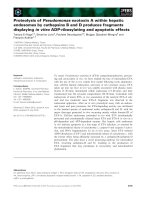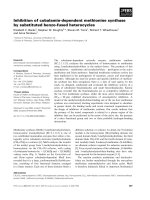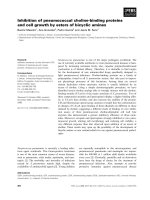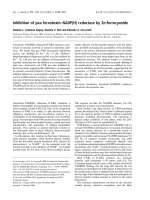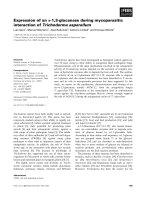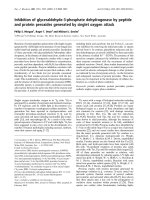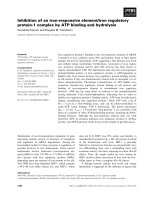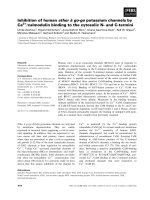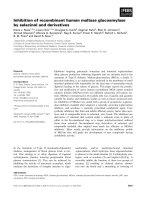Báo cáo khoa học: Inhibition of an iron-responsive element/iron regulatory protein-1 complex by ATP binding and hydrolysis docx
Bạn đang xem bản rút gọn của tài liệu. Xem và tải ngay bản đầy đủ của tài liệu tại đây (845.76 KB, 12 trang )
Inhibition of an iron-responsive element/iron regulatory
protein-1 complex by ATP binding and hydrolysis
Zvezdana Popovic and Douglas M. Templeton
Laboratory Medicine and Pathobiology, University of Toronto, Canada
Mechanisms of post-transcriptional regulation of gene
expression include control of initiation of translation
and regulation of mRNA degradation. Among the
best-studied models for these processes is regulation of
proteins involved in iron homeostasis. These control
mechanisms involve functional iron-responsive ele-
ments (IREs) in the 5¢-UTRs or 3¢-UTRs of mRNAs
that interact with iron regulatory proteins (IRPs),
depending upon the amount of iron present in the cell.
Two IRPs have been identified: IRP-1, which contains
a 4Fe)4S iron–sulfur cluster [1], and IRP-2, which
does not [2,3]. IRP-1 has 30% amino acid identity to
mitochondrial aconitase [4], a 4Fe)4S enzyme involved
in the tricarboxylic acid cycle. IRP-1 is generally
believed to interconvert between an enzymatically inac-
tive IRE-binding state and a nonbinding form with
aconitase activity, the latter requiring an intact 4Fe-4S
cluster. Thus, the simple model for iron sensing by
IRP-1 involves direct association of iron with the iron–
sulfur center to form a complete 4Fe)4S cluster.
A linkage between cellular iron levels and energy
metabolism is suggested by the influence of agents that
Keywords
ATP binding; ATP hydrolysis; energy
metabolism; iron regulatory proteins; iron-
responsive element
Correspondence
D. M. Templeton, Laboratory Medicine and
Pathobiology, University of Toronto, 1 King’s
College Circle, Toronto, Ontario, M5S 1A8,
Canada
Fax: +1 416 978 5959
Tel: +1 416 978 3972
E-mail:
(Received 22 February 2007, revised 29
March 2007, accepted 24 April 2007)
doi:10.1111/j.1742-4658.2007.05843.x
Iron regulatory protein-1 binding to the iron-responsive element of mRNA
is sensitive to iron, oxidative stress, NO, and hypoxia. Each of these agents
changes the level of intracellular ATP, suggesting a link between iron levels
and cellular energy metabolism. Furthermore, restoration of iron regula-
tory protein-1 aconitase activity after NO removal has been shown to
require mitochondrial ATP. We demonstrate here that the iron-responsive
element-binding activity of iron regulatory protein is ATP-dependent in
HepG2 cells. Iron cannot decrease iron regulatory protein binding activity
in cell extracts if they are simultaneously treated with an uncoupler of oxi-
dative phosphorylation. Physiologic concentrations of ATP inhibit iron-
responsive element ⁄ iron regulatory protein binding in cell extracts and
binding of iron-responsive element to recombinant iron regulatory
protein-1. ADP has the same effect, in contrast to the nonhydrolyzable
analog adenosine 5¢-(b,c-imido)triphosphate, indicating that in order to
inhibit iron regulatory protein-1 binding activity, ATP must be hydrolyzed.
Indeed, recombinant iron regulatory protein-1 binds ATP with a K
d
of
86±17lm in a filter-binding assay, and can be photo-crosslinked to
azido-ATP. Upon binding, ATP is hydrolyzed. The kinetic parameters
[K
m
¼ 5.3 lm, V
max
¼ 3.4 nmolÆmin
)1
Æ(mg protein)
)1
] are consistent with
those of a number of other ATP-hydrolyzing proteins, including the RNA-
binding helicases. Although the iron-responsive element does not itself
hydrolyze ATP, its presence enhances iron regulatory protein-1’s ATPase
activity, and ATP hydrolysis results in loss of the complex in gel shift assays.
Abbreviations
AMP-PNP, adenosine 5¢-(b,c-imido)triphosphate; ATP-cS, adenosine 5¢-O-(3-thiotriphosphate); CCCP, carbonyl cyanide
m-chlorophenylhydrazone; EMSA, electrophoretic mobility shift assay; IRE, iron-responsive element; IRP, iron regulatory protein.
3108 FEBS Journal 274 (2007) 3108–3119 ª 2007 The Authors Journal compilation ª 2007 FEBS
affect ATP levels and regulate IRP-1. In addition to
iron, NO [5], H
2
O
2
[5] and oxidative stress in general
[6] influence the activity of IRP-1. All these agents
decrease the level of intracellular ATP, and concomit-
antly increase IRP-1 binding activity, suggesting integ-
rated regulatory mechanisms. In addition, IRP-1 may
be regulated by phosphorylation [7]. Generation of
NO results in an increase in IRP-1 activity, and a
decrease in cytosolic aconitase activity [8–12]. NO
donors also lead to ATP depletion [13], consistent with
inhibition by NO of a number of enzymes involved in
ATP synthesis through glycolysis [14], electron trans-
port, and the tricarboxylic acid cycle [15]. ATP deple-
tion with NO parallels an increase in IRP-1 binding
activity. Exposure to H
2
O
2
promotes removal of the
4Fe)4S cluster of IRP-1, again increasing IRE-binding
activity. It is proposed that the H
2
O
2
-mediated conver-
sion from cytosolic aconitase to an IRE-binding
protein is a result of a signaling pathway rather than
of direct chemical modification of the 4Fe)4S cluster
by H
2
O
2
[9,16,17]. Indeed, superoxide, H
2
O
2
, and HO
are all capable of damaging components of the elec-
tron transport apparatus, and thus can disrupt mitoch-
ondrial function and limit ATP production [18], while
increasing IRP-1 binding activity. Hypoxia also decrea-
ses ATP as cells switch their primary means of energy
production from the tricarboxylic acid cycle to glyco-
lysis [19], and modulates cellular iron homeostasis in
human hepatoma and erythroleukemia cells by enhan-
cing IRP-1 binding capacity [20], although in rodent
cells it has been found to decrease total IRP binding
[21], perhaps due to a higher IRP-2 ⁄ IRP-1 ratio in the
rodent [20].
The present study was undertaken to examine the
possible interaction of ATP with the IRE–IRP system.
We have determined that ATP binds to IRP-1, is
hydrolyzed, and disrupts IRE–IRP-1 binding.
Results
Effect of uncoupling oxidative phosphorylation
on IRP binding activity
We treated HepG2 cells with iron (20 lgÆmL
)1
) for 3 h
in the presence or absence of carbonyl cyanide m-chlo-
rophenylhydrazone (CCCP), and RNA binding was
subsequently examined by electrophoretic mobility
shift assay (EMSA) with human ferritin H-chain IRE.
Iron treatment decreased IRP binding activity to 60%
of control values, but simultaneous treatment with iron
and 10 lm CCCP prevented the iron-dependent
inhibition of IRP binding activity (Fig. 1A). In
parallel, ATP was measured in samples subjected to
each treatment. In the absence of oxidative phosphory-
lation, the ATP levels in CCCP-treated cells were
about half of those in the control cells. Iron treatment
did not significantly affect ATP levels in either CCCP-
treated or control cells (Fig. 1B). Western blots
of IRP-1 demonstrate that the IRP-1 protein level
does not change with iron and ⁄ or CCCP treatment
(Fig. 1C). IRP-2 was weakly detected by western blot-
ting of extracts from HepG2 cells (data not shown).
Purification of IRP-1
Recombinant His-tagged hIRP-1 purified on an Ni
2+
affinity column retained several lower molecular weight
bands (Fig. 2A), some of which were also detectable
by western blotting with antibody to IRP-1 (Fig. 2B),
consistent with lower molecular weight fragments in
both native and recombinant preparations reported
earlier [22]. However, the possibility that these peptides
could present artefactual ATP binding or ATPase
activity prompted us to purify the protein further.
Recombinant IRP-1 was purified to homogeneity by
elution from biotinylated IRE–streptavidin agarose
with 1 m KCl (fraction E2, Fig. 2). Fraction E2 is
essentially pure on an overexposed silver-stained gel
(Fig. 2A), is positive for IRP-1 on western blot
(Fig. 2B), and retains IRE-binding properties on
EMSA (Fig. 2C). Experiments reported below as using
affinity-purified recombinant protein were performed
on material purified as fraction E2.
ATP modulates IRE–IRP interaction in vitro
To determine whether ATP directly influences IRP–
IRE complexation, we incubated HepG2 cell extracts
with different ATP concentrations prior to the addi-
tion of labeled IRE and subsequent EMSA (Fig. 3).
Binding activity was substantially decreased by 2.5 mm
ATP and was undetectable at 5 mm ATP. When puri-
fied recombinant IRP-1 was tested for IRE binding in
the presence of ATP, the results were similar (Fig. 3),
suggesting that interaction can occur among IRP-1,
IRE and ATP without involvement of cellular proteins
lacking IRP activity. Inclusion of 2% b-mercaptoetha-
nol in the reaction mixture had no effect with either
HepG2 extract, Ni
2+
–nitrolotriacetic acid-purified
recombinant protein, or affinity-purified recombinant
protein (Fig. 3B).
ATP is hydrolyzed to inhibit IRE–IRP binding
To determine the specificity of ATP’s effect on the
IRE–IRP interaction, complex formation was studied
Z. Popovic and D. M. Templeton ATP binding to IRP-1
FEBS Journal 274 (2007) 3108–3119 ª 2007 The Authors Journal compilation ª 2007 FEBS 3109
in the presence of other nucleotide triphosphates. CTP,
GTP, and UTP had no significant effect on IRP-1 bind-
ing in either HepG2 cell extracts (Fig. 4A) or with
recombinant protein (Fig. 4B). To determine whether
ATP hydrolysis is required to modulate IRP–IRE inter-
action, we analyzed IRE–IRP complex formation in the
presence of the ATP analogs adenosine 5¢-O -(3-thiotri-
phosphate) (ATP-cS) and adenosine 5¢-(b,c-imido)tri-
phosphate (AMP-PNP). The imidodiphosphate analog
AMP-PNP, which is nonhydrolyzable between the b
and c phosphorus atoms, had no effect on IRE binding
either in cell extracts or with recombinant protein. In
whole cell extracts, the IRE complex was inhibited by
only about 30% by ATP-cS(5mm). However, ATP-cS
had the same inhibitory effect as 5 mm ATP on the
IRE complex formed with recombinant IRP-1. ATP-cS
is hydrolyzed by some phosphatases and ATPases [23],
and the results may reflect a difference between native
and recombinant protein. Furthermore, 5 mm ADP
inhibited the IRP–IRE complex to the same extent as
5mm ATP, suggesting that ATP is hydrolyzed to ADP
to produce the inhibitory effect. Note that after ATP
depletion in Fig. 1, binding is not abolished by cellular
ADP, presumably because [ATP] ⁄ [ADP] ratios are nor-
mally 50–100 in respiring cells [24].
IRP-1 but not IRE has ATPase activity
Having demonstrated that ATP interferes with the
IRE–IRP complex, we performed experiments to
Fig. 1. Effect of an uncoupler of oxidative phosphorylation on IRP binding activity. HepG2 cells growing in complete medium were left
untreated (Control) or treated with 20 lgÆmL
)1
of Fe as ferric ammonium citrate, 10 lM CCCP, or 20 lgÆmL
)1
of Fe and 10 lM CCCP
together, for 3 h. (A) EMSA of IRP–IRE binding activity in total cell extracts using the ferritin IRE probe. Binding activity without b-mercapto-
ethanol treatment was quantified by scanning densitometry of the autoradiograms, and expressed as a percentage of control. Values in the
histogram are means ± SD from three separate experiments. Representative autoradiograms before and after b-mercaptoethanol treatment
are also shown. Values differing from control by one-way ANOVA followed by Dunnett’s test are indicated; *P < 0.05, **P < 0.01. (B) Meas-
urement of cellular ATP levels following treatments as in (A). ATP was measured in whole cell lysates with a luciferin ⁄ luciferase assay kit,
and expressed relative to the values in untreated control cells. Values are means ± SD from three independent experiments expressed relat-
ive to control taken as 100% in each experiment, and statistical differences from control are indicated as in (A). The absolute concentration
in control cells was 2.27 ± 0.79 pmol ATPÆlg
)1
protein. (C) Level of IRP-1 in whole cell extracts following different treatments as in (A).
Equal amounts of protein (80 lg per lane) were subjected to western blot analysis with anti-IRP-1 serum. The position of IRP-1 just above
the 100 kDa molecular mass marker (compare Fig. 2) is indicated by the arrow.
ATP binding to IRP-1 Z. Popovic and D. M. Templeton
3110 FEBS Journal 274 (2007) 3108–3119 ª 2007 The Authors Journal compilation ª 2007 FEBS
establish whether IRE or IRP-1 has ATP hydrolytic
activity. ATPase activities were measured with a sensi-
tive assay that monitors the production of inorganic
[
32
P]phosphate from [
32
P]ATP[cP] by TLC. Recombin-
ant IRP-1 (200–800 ng; 250 nm to 1 lm) has ATPase
activity in the presence of 300 lm ATP (Fig. 5A,B)
that correlates with the amount of protein in the reac-
tion. A reaction with BSA as a protein control had
negligible activity. After boiling of IRP-1 for 5 min,
less than 3% activity remained. Size exclusion chroma-
tography of recombinant IRP-1 could not separate
IRE-binding activity from ATPase activity (data not
shown). Purified IRE RNA was devoid of ATPase
activity (Fig. 5C).
The kinetics of ATP hydrolysis were studied with
affinity-purified recombinant IRP-1. Release of inor-
ganic phosphate was linear with time (Fig. 6A) and
plateaued with increasing protein at about 7 nmol phos-
phateÆmin
)1
Æmg
)1
IRP-1 (Fig. 6B). Dependence on
[ATP] yielded an apparent K
m
value of 5.3 ± 1.7 lm
with respect to ATP hydrolysis and V
max
¼ 3.4 ±
1.7 nmolÆmin
)1
Æmg
)1
(Fig. 6C,D).
ATP hydrolysis can be used for production of
energy to do work or to phosphorylate proteins.
Although we detected free [
32
P]phosphate on TLC,
we still checked for protein phosphorylation by
separation of an ATP hydrolysis mixture containing
IRP-1 by SDS ⁄ PAGE and subsequent autoradiogra-
phy. We could not detect any autophosphorylation of
IRP-1 (data not shown). In a similar experiment,
Eisenstein et al. [25] demonstrated that purified rat
liver IRP-1 is a substrate for different protein kinases
but does not autophosphorylate in the presence of
[
32
P]ATP[cP].
IRP-1 binds ATP
More direct proof that ATP binds directly to IRP-1
was sought in a photolabeling experiment. Recombin-
ant IRP-1 was incubated with 8-azido-[
32
P]ATP[aP]
for 2 min at 4 °C, and this was followed by UV-
induced covalent crosslinking of bound [a-
32
P]nucleo-
tide. The proteins were separated by SDS ⁄ PAGE, and
AB
C
Fig. 3. ATP inhibits IRP–IRE binding activity. IRE binding activity
was measured by EMSA using either cytosolic extract from HepG2
cells or recombinant human IRP-1 after addition of the indicated
concentration of ATP. A representative gel is shown in (A), and the
values in the histograms (C) are means ± SD from three independ-
ent experiments. Values marked *** differ from control ([ATP] ¼ 0)
at P < 0.001. (B) EMSA of HepG2 cell extracts, Ni
2+
–nitrilotriacetic
acid-purified ecombinant IRP-1 (Ni-IRP-1), and affinity-purified IRP-1
(A-IRP-1) without ATP, with 5 m
M ATP, or with 5 mM ATP plus 2%
b-mercaptoethanol (ME).
Fig. 2. Purification of IRP-1. Recombinant IRP-1 was purified from E. coli by Ni
2+
–nitrilotriacetic acid agarose chromatography and IRE affinity
chromatography. (A) Silver-stained gels of molecular mass markers (lane M; sizes in kDa indicated by arrows), crude E. coli lysate (lane L),
200 ng (N2) and 100 ng (N1) of Ni
2+
–nitrilotriacetic acid agarose-purified IRP-1, and 10 lL aliquots of successive 50 lL elutions from an IRE
affinity column with 1
M KCl-containing elution buffer (E1, E2). (B) Western blot analysis with IRP-1 antibody. Lanes represent 500 ng of
Ni
2+
–nitrilotriacetic acid agarose-purified IRP-1 (N5), and IRE affinity chromatography flow through (FT), wash (W), and successive 1 M KCl
elutions (E1–E4). (C) IRE binding activity by EMSA of 500 ng of Ni
2+
–nitrilotriacetic acid agarose-purified IRP-1 (N5), and IRE affinity chroma-
tography flow through (FT), wash (W), and 1
M KCl elutions (E1, E2).
Z. Popovic and D. M. Templeton ATP binding to IRP-1
FEBS Journal 274 (2007) 3108–3119 ª 2007 The Authors Journal compilation ª 2007 FEBS 3111
proteins that had bound to 8-azido-[
32
P]ATP[aP] were
visualized by autoradiography of dried gels. Specificity
of binding to IRP-1 was demonstrated by competition
with unlabeled ATP, ATP-cS, and unlabeled 8-azido-
ATP, and by lack of competition with the related pur-
ine nucleotide, GTP (Fig. 7A,B). Binding of increasing
amounts of 8-azido-[
32
P]ATP[aP] (Fig. 7C) indicated a
K
d
>30lm. To characterize the binding further, a
filter-binding assay was performed with up to 500 lm
[
32
P]ATP[aP] and gave a K
d
¼ 86 ± 17 lm (Fig. 7D).
ATPase activity is enhanced in the presence
of IRE
Binding to RNA and ATPase activity are characteris-
tics of RNA helicases, and RNA binding increases the
ATPase activity of these proteins [26]. To test whether
the ATPase activity of IRP-1 is also enhanced in the
presence of IRE, we measured hydrolysis of
[
32
P]ATP[cP] in the presence of 0–400 ng of IRE
(Fig. 8). Compared to the amount of ATP hydrolyzed
with 400 ng of IRP alone, addition of IRE increased
the release of inorganic [
32
P]phosphate by about 50%.
IRE alone at 400 ng had no hydrolytic activity
(Fig. 5C).
Discussion
We have demonstrated here that treatment of HepG2
cells with an uncoupler of oxidative phosphorylation
depleted them of ATP and prevented suppression of
Fig. 4. Requirement for ATP hydrolysis to inhibit IRP–IRE binding
activity. EMSA was performed for IRE binding to HepG2 cytosolic
extract (upper panel) or recombinant IRP-1 (lower panel). The first
lane in each panel is without added nucleotide. In subsequent
lanes, the indicated nucleotide analog was added prior to protein,
to a final nucleotide concentration of 5 m
M. Representative auto-
radiograms are shown, and the bars show means ± SD of the
intensities from separate experiments (HepG2 extract, n ¼ 4;
recombinant IRP-1, n ¼ 3), expressed relative to the nucleotide-free
lane, taken as 100%. Values marked ** are significantly lower than
the nucleotide-free lane; P < 0.01.
A
B
C
Fig. 5. Recombinant IRP-1 has ATPase activity. (A) TLC autoradio-
gram of [
32
P]ATP[cP] reaction mixtures containing 300 lM ATP in
the presence of increasing amounts of recombinant IRP-1. The
position of free inorganic phosphate is indicated by the arrow. In
the last lane, 800 lg of BSA is included as a nonspecific protein
control. (B) Combined results (means ± SD) of three repetitions of
experiments as in (A), with inorganic phosphate quantitated by
scraping and scintillation counting. Significant increases in the pres-
ence of IRP-1 are indicated; **P < 0.01, ***P < 0.001. (C) TLC
autoradiogram of [
32
P]ATP[cP] reaction mixtures in the presence of
increasing amounts of IRE mRNA.
ATP binding to IRP-1 Z. Popovic and D. M. Templeton
3112 FEBS Journal 274 (2007) 3108–3119 ª 2007 The Authors Journal compilation ª 2007 FEBS
IRP activity by iron. A similar effect of CCCP-induced
ATP depletion was observed on the reconstitution of
cytosolic and mitochondrial aconitase activities after
removal of NO-generating agents [27]. That is, the
high IRE-binding activity of IRP-1 after NO exposure
remained elevated in CCCP-treated cells after cessation
of NO flux. Moreover, Bouton et al. [27] also observed
that IRP-1 cannot dissociate from IRE if mitochondria
are unable to produce ATP. They suggested that IRP-
1–IRE complex dissociation, an obligate step upstream
of 4Fe)4S cluster repair, utilizes an ATP-dependent
mechanism. Although this is a plausible explanation
for our results, we have not attempted to rule out
other possibilities. For instance, interference with mito-
chondrial function and dissipation of the mitochond-
rial transmembrane potential by CCCP could prevent
reconstitution by interfering with mitochondrial
4Fe)4S cluster synthesis, although Li et al. have dem-
onstrated that reconstitution of mammalian cytosolic
aconitase probably involves cytosolic forms of enzymes
of cluster synthesis [28].
Although iron treatment has a dramatic impact on
iron–sulfur proteins and the bioenergetic function of
mitochondria [29], 3 h of iron treatment of our HepG2
cultures did not significantly increase the ATP level
compared to that in control cells (Fig. 1). Oexle et al.
[30] found a significant increase in ATP after 24 h in
iron-treated, differentiating K562 cells as compared to
control or deferoxamine-treated cells, and aconitase
activity was also increased in iron-treated cells, as
expected. Thus, one may speculate that iron regulates
IRP binding activity in part through changes in ATP
concentration (Fig. 1) and ⁄ or that ATP is required for
iron-mediated regulation of IRP-1 binding activity. On
the other hand, a K
d
of 86 lm argues against direct
regulation of IRP-1 binding by ATP. Total cellular
ATP levels are c.5mm [32], and this would suggest
that IRP-1 would be saturated with ATP under normal
circumstances, preventing IRE binding. Indeed, this
might account for the observation, derived from IRP-1
gene-ablated mice, that IRP-2 rather than IRP-1 is
responsible for the post-transcriptional regulation of
iron homeostasis, and that IRP-1 functions as a cyto-
solic aconitase, rather than as an RNA-binding pro-
tein, in most cells [33]. However, the lower K
m
values
of many ATPases in the micromolar range suggest that
they experience lower local concentrations of ATP, e.g.
due to compartmentalization. Furthermore, at least
50% of cytosolic ADP is protein-bound [34]. Thus,
whether IRP-1 experiences subsaturating cytosolic
ATP concentrations in the cell remains an open ques-
tion. Certainly, our estimated K
m
value of 5.3 lm is
quite in keeping with the values reported for a number
of other ATP-hydrolyzing proteins, e.g. Escherichia coli
DnaK (20 lm) [35], Hsc70 (1.4 lm) [36], and F1-
ATPase (15 lm) [37]. Furthermore, these proteins have
V
max
values in the range 1.1–3.5 nmolÆmin
)1
Æmg
)1
,
comparable to the value of 3.4 nmolÆmin
)1
Æmg
)1
measured here, supporting a physiologic relevance
of the observed ATP binding.
The requirement for more than 1 mm ATP to abol-
ish binding in EMSA (Fig. 3) is at first sight inconsis-
tent with a K
d
of 86 lm. The K
m
and K
d
values are in
reasonable agreement, and it may be that factors other
AB
CD
Fig. 6. Kinetics of ATP hydrolysis by affinity-
purified recombinant IRP-1. (A) Time
dependence of ATP hydrolysis. IRP-1
(20 ng) was incubated in a final volume of
20 lL with 10 n
M [
32
P]ATP[cP] in the pres-
ence of 10 l
M ATP for 1 h, and [
32
P]phos-
phate release was measured by TLC. (B)
Dependence of ATP hydrolysis on IRP-1
concentration. The indicated amount of IRP
was included in the reaction with conditions
as in (A). (C) A representative thin layer
chromatogram of ATP hydrolysis with 20 ng
of affinity-purified recombinant IRP-1, 10 n
M
[
32
P]ATP[cP] and the indicated amount of
unlabeled ATP for 1 h. Bk is the reaction
mixture with no added IRP-1 or cold ATP.
(D) Rate data calculated from (C). Nonlinear
regression (r
2
¼ 0.67) of the rate data gives
K
m
¼ 5.3 ± 1.7 lM and V
max
¼ 3.4 ± 0.3
nmolÆmin
)1
Æmg
)1
.
Z. Popovic and D. M. Templeton ATP binding to IRP-1
FEBS Journal 274 (2007) 3108–3119 ª 2007 The Authors Journal compilation ª 2007 FEBS 3113
than binding and hydrolysis, e.g. a conformational
change induced by high ATP concentrations, are
necessary for disruption of RNA binding. However,
other factors in the EMSA protocol, including changes
in Mg
2+
and ATP concentrations during electropho-
retic separation, may influence binding, and we think
this the more likely explanation; direct comparison of
the ATP dependence of EMSA and binding of ATP to
purified protein under optimized conditions may not be
appropriate. Nor can the concentration of ATP neces-
sary to disrupt IRP–IRE binding on EMSA be readily
compared to effective concentrations in vivo, where
additional interactions may be involved.
Disruption of the 4Fe)4S cluster of IRP-1 with 2%
b-mercaptoethanol is widely used to uncover total
IRP-1 binding activity. However, in our experiments
addition of 2% b-mercaptoethanol did not reconstitute
IRP-1 binding inhibited by ATP, and nor was the pro-
tein degraded. Similarly, Gonzalez et al. [38] reported
that IRP binding activity inhibited by interferon-c ⁄
lipopolysaccharide-dependent NO production and
phorbol ester treatment was not recovered by exposure
of IRP-1 to 2% b-mercaptoethanol, and nor was
this due to protein degradation. Furthermore, we
previously found that b-mercaptoethanol somewhat
diminished the binding activity achieved by in vitro
treatment with deferoxamine [39]. Thus, while
b-mercaptoethanol can disrupt the 4Fe)4S cluster and
facilitate binding of IRP-1, it may also decrease bind-
ing by opening up the protein to internal disulfide
bond formation [40]. These data suggest a novel mech-
anism for ATP-dependent inhibition of IRP-1 binding
activity that cannot be recovered by reductive treat-
ment with b-mercaptoethanol.
We demonstrate a requirement for ATP hydrolysis
in order to inhibit recombinant IRP-1 binding activity,
and both ATP and ADP suppress binding (Fig. 3).
The mechanism of activation of IRP-1 by oxidative
stress might well involve ATP. Thus, IRP-1 activation
with H
2
O
2
requires Mg
2+
, and is sensitive to treatment
with alkaline phosphatase that results in a 90% reduc-
tion of ATP levels [41]. Furthermore, ATP-cS and
GTP-cS inhibited IRP-1 activation by H
2
O
2
signifi-
cantly. Pantopoulos & Hentze [41] conclude that
IRP-1 activation by H
2
O
2
in permeabilized cells
appears to require ATP and GTP, indicating an energy
dependence of the process and ⁄ or the involvement of a
phosphorylation–dephosphorylation cycle. We found
that ATP-cS causes only about 30% inhibition of
binding in whole cell extracts but 80% inhibition with
recombinant protein, and this difference may arise
from different characteristics of native HepG2 protein
and recombinant protein, such as the presence of a
His-tag on the latter. Although ATP-cS is often con-
sidered a nonhydrolyzable ATP analog, it undergoes
hydrolysis in some circumstances, and is a substrate
for RNA-dependent nucleotide hydrolysis by helicases
[23]. Because hydrolysis of a phosphorothioate group
is actually predicted to be faster than that of the
corresponding phosphate on the basis of chemical
considerations, it has been suggested that the rate-
determining step may be a conformational change that
takes place after substrate binding [23]. Native and
recombinant proteins may have different conforma-
A
B
D
C
Fig. 7. Photolabeling of IRP-1 with 8-azido-ATP. (A) Two hundred
nanograms of affinity-purified recombinant IRP-1 was reacted with
5 l
M 8-azido-[
32
P]ATP[aP], and then subjected to gradient
SDS ⁄ PAGE; and the gel was then silver stained (Ag), and autoradio-
graphed (
32
P). The arrow indicates the position of IRP-1 at 105 kDa.
(B) Autoradiograph after photo-crosslinking of 4 lg portions of
Ni
2+
–nitrilotriacetic acid-purified recombinant IRP-1 with 5 lM 8-azi-
do-[
32
P]ATP[aP] alone in control lanes (C), or in the presence of
competitors: 20 m
M ATP (A2), 20 mM GTP (G2), 100 mM ATP
(A10), 100 m
M GTP (G10), 20 mM ATP-cS(c), and 20 mM unlabeled
8-azido-ATP (Z). (C) Photo-crosslinking of 4 lg portions of Ni
2+
–nitril-
otriacetic acid-purified recombinant IRP-1 with increasing concentra-
tions of 8-azido-[
32
P]ATP[aP] as indicated. The reaction mixture was
electrophoresed, silver stained, and autoradiographed. (D) Filter-
binding assay of 0.62 lg of IRP-1 incubated with 100 n
M
[
32
P]ATP[aP] and the indicated concentration of unlabeled ATP.
The reaction mixture was collected on nitrocellulose membranes
as described in Experimental procedures. The saturation plot
was fitted by nonlinear regression (r
2
¼ 0.98) to give values of
K
d
¼ 86 ± 17 lM and B
max
¼ 4.6 ± 0.3, typical of three such
experiments.
ATP binding to IRP-1 Z. Popovic and D. M. Templeton
3114 FEBS Journal 274 (2007) 3108–3119 ª 2007 The Authors Journal compilation ª 2007 FEBS
tional flexibilities. Alternatively, lower inhibition by
ATP-cS in cell extracts may be due to the presence of
additional cellular proteins from HepG2 cytosol that
are involved in IRP–IRE complex formation. Further-
more, ATP-cS, but not AMP-PNP, inhibited IRP–IRE
binding in extracts from fibroblasts treated with the
analogs in culture [41]. Therefore, the 30% inhibition
of binding in our cell extracts still suggests that ATP
should be hydrolyzed in order to interact with the
IRP-1–IRE complex. This is confirmed by the lack of
any effect of the nonhydrolyzable imidodiphosphate
analog AMP-PNP.
Direct binding of ATP to IRP-1 was demonstrated
by photolabeling with radioactive photosensitive 8-azi-
do-[
32
P]ATP[aP] (Fig. 7), a method that has been used
to identify ATP-binding sites on proteins, e.g. on histi-
dine permease [42] and chaperonin GroEL [43]. Labe-
ling with 8-azido-[
32
P]ATP[aP], together with evidence
of binding of [
32
P]ATP[aP] but not [
32
P]ATP[cP] in the
filter assay (data not shown), is a strong indication of
an ATPase activity of IRP-1. Competition by ATP
and analogs, but not GTP (Fig. 7) or CTP (data not
shown), supports specificity of the binding site(s). A
large excess of unlabeled ATP was necessary to elimin-
ate the signal. The reason for this is unknown, but it
has been observed previously in similar ATP photo-
labeling experiments [44–47].
A simple model, then, is that IRP-1 is bound
to RNA at lower ATP concentrations, but at higher
concentrations it hydrolyzes ATP and dissociates from
RNA. This means that a low local ATP level main-
tains the IRP-1–IRE complex at high iron concentra-
tion, and when the ATP level increases, the complex
dissociates. Increased ATP hydrolysis in the presence
of IRE is reminiscent of an important ATPase protein
family ) the helicases [48]. They unwind duplex RNAs
in concert with the hydrolysis of nucleoside. For
example, the RNA-binding helicase eIF4A undergoes
cyclic conformational changes upon ATP binding and
hydrolysis such that the eIF4A–ADP complex has a
greatly decreased affinity for ssRNA [26]. Our data do
not show whether ATP inhibits the binding of IRP-1
to IRE, or instead facilitates dissociation of the com-
plex. Enhancement of ATP hydrolysis by IRE in the
presence of IRP-1, but absence of hydrolysis in the
presence of IRE alone, suggests that ATP may interact
with the complex. However, the enhancement is not
dramatic, and whether ATP inhibits formation or
increases dissociation of the IRE–IRP-1 complex can-
not be definitively determined from the present data.
If formation of the IRP-1–IRE complex depends on
iron concentration, but its dissociation depends on
ATP concentration, then the expression of IRE-con-
taining genes would actually depend on both iron and
ATP levels. At low ATP levels, transferrin receptor
mRNA would be stable, and transferrin receptor on
the membrane would continue to take up iron. In par-
allel, ferritin mRNA (and other 5¢-IRE mRNAs)
would still have IRP-1 bound, and ferritin synthesis
would be blocked, so iron would not be stored in ferr-
itin but relocated to iron-binding proteins, many of
them located in mitochondria and involved in energy
metabolism. The present observations suggest an
expanded role for the IRE–IRP system in regulating
cellular energy metabolism.
Experimental procedures
Cell culture and iron loading
HepG2 cells (no. HB 8065) were obtained from the Ameri-
can Type Culture Collection (Rockville, MD) and grown in
a-MEM supplemented with 10% fetal bovine serum, peni-
cillin (100 UÆmL
)1
) and streptomycin (100 lgÆmL
)1
). Cells
AB
Fig. 8. IRE stimulates ATPase activity of
IRP-1. (A) Hydrolysis reaction of
[
32
P]ATP[cP]. The blank contains neither pro-
tein nor RNA. Other lanes contain 400 ng of
recombinant IRP-1 and the indicated amount
of IRE RNA. Values are means ± SD from
three separate experiments. *Significantly
greater than IRP-1 alone (P<0.05). (B)
Autoradiogram of a thin layer chromatogram
showing the release of [
32
P]phosphate.
Lanes are as in (A).
Z. Popovic and D. M. Templeton ATP binding to IRP-1
FEBS Journal 274 (2007) 3108–3119 ª 2007 The Authors Journal compilation ª 2007 FEBS 3115
were plated at a density of 4 · 10
6
cells per 60 mm dish,
allowed to attach and grow overnight, and then treated
with iron (20 lgÆmL
)1
) as ferric ammonium citrate, 10 lm
CCCP, or both. After 3 h, cells were harvested and protein
was extracted (see below).
Preparation of cytoplasmic extracts
Monolayers of HepG2 cells were scraped in NaCl ⁄ P
i
and
centrifuged at 11 000 g for 1 min with an Eppendorf 5415R
centrifuge. The pellet was resuspended in extraction buffer
(EB: 10 mm Hepes, pH 7.6, 3 mm MgCl
2
,40mm KCl,
1mm dithiothreitol, 0.2% Nonidet P-40). After sonication
for 5 s, the suspension was centrifuged for 1 min at
11 000 g with an Eppendorf 5415R centrifuge. The super-
natant was recentrifuged under the same conditions for use
in the IRE-binding assay [49]. The protein content of the
extracts was determined with a Bradford-based protein
determination kit (Bio-Rad, Mississauga, ON, Canada).
The protein extract was aliquoted and stored at ) 80 °C.
Preparation of RNA transcripts
Transcription was performed in vitro with 1 lgofBamH1
linearized plasmid pSPTfer [50], coding the human ferritin
H-chain IRE (provided by L. C. Ku
¨
hn, ISREC, Epalinges,
Switzerland) in the presence of 50 lCi of [
32
P]CTP[aP]
(800 CiÆmmol
)1
; ICN, Costa Mesa, CA) and T7 RNA
Polymerase using a Promega in vitro transcription system
(Promega, Madison, WI). Full-length transcripts were puri-
fied on QuickSpin columns (Roche Molecular Biochemicals,
Laval, PQ, Canada) for radiolabeled RNA purification
according to the manufacturer’s procedure.
Purification of recombinant IRP-1
Human recombinant IRP-1 was purified from E. coli trans-
formed with pT7-his-IRP-1 plasmid (a gift from K Pantop-
oulos, McGill University) as previously described [51].
Bacterial pellets were resuspended in 20 mm Tris ⁄ HCl
(pH 8.0), with 250 mm NaCl and 0.5% Nonidet P-40, fro-
zen, thawed, and sonicated. The lysates were clarified by
centrifugation (4300 g, Sorvall centrifuge with SS34 rotor).
Ni
2+
–nitrilotriacetic acid agarose beads (Qiagen, Mississ-
auga, ON, Canada) were washed twice with buffer N
(24 mm Hepes, pH 7.6, with 150 mm potassium acetate,
1.5 mm MgCl
2
, and 5% glycerol). KCl was added to the
lysate to a final concentration of 0.4 m, and the lysate was
tumbled with Ni
2
–nitrilotriacetic acid agarose beads for 1 h
at 4 °C. This mixture was poured into a column and
washed sequentially at 4 °C with buffer N plus 0.4 m KCl,
buffer N alone, and buffer N with 5 mm imidazole. IRP-1
was eluted with buffer N containing 50 mm imidazole.
Recombinant protein was further purified with the use of
streptavidin-conjugated paramagnetic spheres (Invitrogen
Canada Inc., Burlington, ON, Canada) and biotinylated
IRE RNA [52]. For biotinylation, 100 lL of a transcription
reaction mixture was prepared containing 5 lLof10mm
GTP, UTP and ATP, 2.5 lLof10mm CTP, and 2.5 lLof
10 mm biotin-14-CTP (Invitrogen Canada Inc.) according
to the manufacturer’s instruction. Biotin-14-CTP is a CTP
analog that contains biotin attached to the N4 position via
a 14-atom linker. Full-length transcripts were purified on
QuickSpin columns and used for affinity chromatography.
Streptavidin beads (100 lL) were washed two times with
200 lL of binding buffer (20 mm Hepes, pH 7.5, 150 mm
KCl, 1 mm phenylmethanesulfonyl fluoride), resuspended in
100 lL of binding buffer, and added to biotinylated IRE
(10 lg in 150 lL of binding buffer). Biotinylated IRE was
bound to streptavidin beads for 10 min at 4 °C, and
unbound IRE was washed with 100 lL of binding buffer.
Fifty micrograms of fresh IRP-1 was then added to mag-
netic beads in 100 mm KCl in 200 lL of binding buffer,
and tumbled for 90 min at 4 °C. Beads were washed three
times with 400 lL of washing buffer (20 mm Hepes,
pH 7.5, 150 mm KCl, 2 mm MgCl
2
, 0.5 mm dithiothreitol,
0.5 mm phenylmethanesulfonyl fluoride, 5% glycerol, and
0.1% Nonidet P-40), and eluted five times with 50 lLof
elution buffer (50 mm Hepes, pH 7.5, 0.5 mm EDTA, 1 m
KCl, 1 mm phenylmethanesulfonyl fluoride, 5% glycerol).
EMSA
RNA–protein interactions were analyzed in cytoplasmic
extracts containing 15–30 lg of total protein, or with
400 ng of Ni
2+
–nitrilotriacetic acid-isolated recombinant
IRP-1 or 20 ng of affinity-purified IRP-1. Extracts were
mixed with a molar excess of labeled ferritin H-chain IRE
(10 ng) in EB buffer without Nonidet P-40 and with or
without ATP (final volume 20 lL). In some experiments,
various nucleotide analogs were added at 5 mm final con-
centration to the EB buffer prior to adding protein and
IRE. RNAse T1 was added after 10 min of incubation, and
2 lL of 2.5 mgÆmL
)1
heparin was added after a further
10 min for an additional 10 min period. IRE–IRP com-
plexes were resolved in 6% nondenaturing polyacrylamide
gels. In some experiments, parallel samples were treated
with 2% b-mercaptoethanol before addition of the labeled
RNA probe to unmask total IRP binding activity.
Western blot analysis
Proteins were resolved by 8% SDS ⁄ PAGE, transferred to
nitrocellulose membranes, incubated with antibodies to
IRP-1 or IRP-2 (Alpha Diagnostic International, San Anto-
nio, TX) (1 : 5000 dilution), and detected using ECL west-
ern blot detection reagents (Amersham Bioscience, Baie
d’Urfe
´
, PQ, Canada).
ATP binding to IRP-1 Z. Popovic and D. M. Templeton
3116 FEBS Journal 274 (2007) 3108–3119 ª 2007 The Authors Journal compilation ª 2007 FEBS
8-Azido-[
32
P]nucleotide binding experiments
Recombinant human IRP-1 (0.2–4 lg) was combined with
8-azido-[
32
P]ATP[aP] (Affinity Labeling Technologies, Lex-
ington, KY; specific activity 10–15 CiÆmmol
)1
) at a final
concentration of 20 lm and assay buffer (25 mm Tris,
pH 7.6, 100 mm KCl, 5 mm MgCl
2
and 10% glycerol) in a
total volume of 20 lL according to the manufacturer’s pro-
tocol. After 2 min of incubation on ice, the samples were
crosslinked immediately with a 254 nm UV lamp for 2 min.
The samples were separated on either a 4–15% gradient or
8% SDS ⁄ PAGE gels (Bio-Rad), silver stained, dried, and
exposed to X-ray film.
Filter-binding assay
ATP-binding activity was determined by a filter-binding
assay as previously described [53]. IRP-1 (0.5–1 lg) was
incubated with 100 nm [
32
P]ATP[aP] (Perkin Elmer Can-
ada, Woodridge, ON, Canada; 3000 CiÆmmol
)1
) at room
temperature for 30 min in 20 lL of binding buffer (25 mm
Tris, pH 7.6, 100 mm KCl, 5 mm MgCl
2
,1mm dithiothrei-
tol, and 10% glycerol) containing different concentrations
of unlabeled ATP. Nitrocellulose membranes were soaked
briefly in 0.4 m KOH, rinsed thoroughly, and mounted on
a dot blot apparatus. The binding reaction was stopped by
addition of 70 lL of ice-cold buffer, and the reaction mix-
ture was loaded on the dot blot appratus in triplicate 30 lL
aliquots, and washed twice with 200 lL of cold binding
buffer. Nitrocellulose membranes were exposed to film, and
each spot was cut out and counted by liquid scintillation.
ATP hydrolysis and TLC
ATP hydrolysis was determined by measuring the release of
[
32
P]phosphate from [
32
P]ATP[cP] (Perkin Elmer Canada;
3000 CiÆmmol
)1
) [36]. IRP-1 was added to 10 nm [
32
P]ATP
[cP] in 25 mm Tris ⁄ HCl (pH 7.6), 100 mm KCl, 5 mm
MgCl
2
, 10% glycerol and varying concentration of ATP in
a final volume of 20 lL. After incubation for 60 min at
room temperature, 2 lL was spotted on polyethyleneimine
cellulose TLC plates (Sigma, St Louis, MO, USA). IRE
(100–800 ng) was analyzed under the same conditions. The
spotted samples were resolved using 0.5 m lithium chloride
in 0.5 m formic acid and visualized by autoradiography.
Spots containing the released [
32
P]phosphate were cut and
measured by scintillation counting.
ATP measurement
To extract ATP, cells were harvested in cold 0.6 m HClO
4
and centrifuged at 9000 g for 1 min with an Eppendorf
5415R centrifuge. The pellet was saved for protein deter-
mination by Lowry’s method [54,55]. The supernatant was
neutralized with 5 m KOH and 0.4 m imidazole, and centri-
fuged again. Aliquots of ATP-containing extract were saved
at ) 80 °C. ATP was measured with a commercial lucifer-
in ⁄ luciferase (ENLITEN) kit (Promega) according to the
manufacturer’s protocol. Briefly, 100 l L of a 1 : 500 diluted
sample was added to a microplate, and 50 lL of ENLITEN
rL ⁄ L reagent was added immediately before measurement
and mixed by repeated pipetting. Measurements were taken
in a microplate luminometer (MicroLumat Plus; ED & G
Berthold, Gaithersburg, MD, USA). Three measurements
were made for each sample and were compared to a stan-
dard curve of ATP solutions ranging from 10 to 750 nm.
Statistical methods
Values from multiple experiments are expressed as
mean ± SD. Differences between means in multiple com-
parisons were analyzed by one-way anova. Comparisons of
multiple values against a control value were performed
using Dunnett’s post hoc test. Kinetic data and binding
plots were fitted by nonlinear regression using the program
prism (GraphPad Software, San Diego, CA).
Acknowledgements
This work was supported by grants from the Heart
and Stroke Foundation of Canada (grant T4134) and
the Canadian Institutes of Health Research (grant
MT11270). We thank Dr Tania Christova for helpful
discussions.
References
1 Kennedy MC, Mende-Mueller L, Blondin GA & Beinert
H (1992) Purification and characterization of cytosolic
aconitase from beef liver and its relationship to the
iron-responsive element binding protein. Proc Natl Acad
Sci USA 89, 11730–11734 (erratum appears in Proc Natl
Acad Sci USA 90, 2556).
2 Samaniego F, Chin J, Iwai K, Rouault TA & Klausner
RD (1994) Molecular characterization of a second iron-
responsive element binding protein, iron regulatory
protein 2. Structure, function, and post-translational
regulation. J Biol Chem 269, 30904–30910.
3 Guo B, Yu Y & Leibold EA (1994) Iron regulates cyto-
plasmic levels of a novel iron-responsive element-bind-
ing protein without aconitase activity. J Biol Chem 269,
24252–24260.
4 Rouault TA, Stout CD, Kaptain S, Harford JB &
Klausner RD (1991) Structural relationship between an
iron-regulated RNA-binding protein (IRE-BP) and aco-
nitase: functional implications. Cell 64, 881–883.
5 Martins EL, Robalinho RL & Meneghini R (1995) Oxi-
dative stress induces activation of a cytosolic protein
Z. Popovic and D. M. Templeton ATP binding to IRP-1
FEBS Journal 274 (2007) 3108–3119 ª 2007 The Authors Journal compilation ª 2007 FEBS 3117
responsible for control of iron uptake. Arch Biochem
Biophys 316, 128–134.
6 Pantopoulos K & Hentze MW (1995) Rapid responses
to oxidative stress mediated by iron regulatory protein.
EMBO J 14, 2917–2924.
7 Schalinske KL & Eisenstein RS (1996) Phosphorylation
and activation of both iron regulatory proteins 1 and 2
in HL-60 cells. J Biol Chem 271, 7168–7176.
8 Pantopoulos K & Hentze MW (1995) Nitric oxide sig-
naling to iron-regulatory protein: direct control of ferri-
tin mRNA translation and transferrin receptor mRNA
stability in transfected fibroblasts. Proc Natl Acad Sci
USA 92, 1267–1271.
9 Pantopoulos K, Weiss G & Hentze MW (1996) Nitric
oxide and oxidative stress (H2O2) control mammalian
iron metabolism by different pathways. Mol Cell Biol
16, 3781–3788.
10 Hentze MW & Ku
¨
hn LC (1996) Molecular control of
vertebrate iron metabolism: mRNA-based regulatory
circuits operated by iron, nitric oxide, and oxidative
stress. Proc Natl Acad Sci USA 93, 8175–8182.
11 Kim S & Ponka P (2002) Nitrogen monoxide-mediated
control of ferritin synthesis: implications for macro-
phage iron homeostasis. Proc Natl Acad Sci USA 99,
12214–12219.
12 Kim S & Ponka P (2003) Role of nitric oxide in cellular
iron metabolism. Biometals 16, 125–135.
13 Salzman AL, Menconi MJ, Unno N, Ezzell RM, Casey
DM, Gonzalez PK & Fink MP (1995) Nitric oxide
dilates tight junctions and depletes ATP in cultured
Caco-2BBe intestinal epithelial monolayers. Am
J Physiol 268, G361–G373.
14 Dimmeler S, Lottspeich F & Brune B (1992) Nitric
oxide causes ADP-ribosylation and inhibition of glycer-
aldehyde-3-phosphate dehydrogenase. J Biol Chem 267,
16771–16774.
15 Stadler J, Billiar TR, Curran RD, Stuehr DJ, Ochoa JB
& Simmons RL (1991) Effect of exogenous and endo-
genous nitric oxide on mitochondrial respiration of rat
hepatocytes. Am J Physiol 260, C910–C916.
16 Mueller S & Pantopoulos K (2002) Activation of iron
regulatory protein-1 by oxidative stress. Methods Enzy-
mol 348, 324–337.
17 Pantopoulos K (2004) Iron metabolism and the
IRE ⁄ IRP regulatory system: an update. Ann NY Acad
Sci 1012, 1–13.
18 Heck DE, Kagan VE, Shvedova AA & Laskin JD
(2005) An epigrammatic (abridged) recounting of the
myriad tales of astonishing deeds and dire conse-
quences pertaining to nitric oxide and reactive oxygen
species in mitochondria with an ancillary missive con-
cerning the origins of apoptosis. Toxicology 208,
259–271.
19 Harris A (2002) Hypoxia ) a key regulatory factor in
tumour growth. Nat Rev Cancer 2, 38–47.
20 Toth I, Yuan LP, Rogers JT, Boyce H & Bridges KR
(1999) Hypoxia alters iron-regulatory protein-1 binding
capacity and modulates cellular iron homeostasis in
human hepatoma and erythroleukemia cells. J Biol
Chem 274, 4467–4473.
21 Hanson ES, Foot LM & Leibold EA (1999) Hypoxia
post-translationally activates iron-regulatory protein 2.
J Biol Chem 274, 5047–5052.
22 Popovic Z & Templeton DM (2005) A Northwestern
blotting approach for studying iron regulatory element-
binding proteins. Mol Cell Biochem 268 , 67–74.
23 Peck ML & Herschlag D (2003) Adenosine 5¢-O-(3-thio)
triphosphate (ATPcS) is a substrate for the nucleotide
hydrolysis and RNA unwinding activities of eukary-
otic translation initiation factor eIF4A. RNA 9, 1180–
1187.
24 Erecinska M & Wilson DF (1982) Regulation of cellular
energy metabolism. J Membrane Biol 70, 1–14.
25 Eisenstein RS, Tuazon PT, Schalinske KL, Anderson
SA & Traugh JA (1993) Iron-responsive element-bind-
ing protein. Phosphorylation by protein kinase C. J Biol
Chem 268, 27363–27370.
26 Lorsch JR & Herschlag D (1998) The DEAD box pro-
tein eIF4A. 1. A minimal kinetic and thermodynamic
framework reveals coupled binding of RNA and nucleo-
tide. Biochemistry 37, 2180–2193.
27 Bouton C, Chauveau MJ, Lazereg S & Drapier JC
(2002) Recycling of RNA binding iron regulatory pro-
tein 1 into an aconitase after nitric oxide removal
depends on mitochondrial ATP. J Biol Chem 277,
31220–31227.
28 Li K, Tong W-H, Hughes RM & Rouault TA (2006)
Roles of the mammalian cytosolic cysteine desulfurase,
ISCS, and scaffold protein, ISCU, in iron–sulfur cluster
assembly. J Biol Chem 281, 12344–12351.
29 Rouault TA & Tong WH (2005) Iron–sulphur cluster
biogenesis and mitochondrial iron homeostasis. Nat Rev
Mol Cell Biol 6, 345–351.
30 Oexle H, Gnaiger E & Weiss G (1999) Iron-dependent
changes in cellular energy metabolism: influence on
citric acid cycle and oxidative phosphorylation. Biochem
Biophys Acta 1413, 99–107.
31 Lipinski P, Starzynski RR, Drapier JC, Bouton C, Bart-
lomiejczyk T, Sochanowicz B, Smuda E, Gajkowska A
& Kruszewski M (2005) Induction of iron regulatory
protein 1 RNA-binding activity by nitric oxide is asso-
ciated with a concomitant increase in the labile iron
pool: implications for DNA damage. Biochem Biophys
Res Commun 327 , 349–355.
32 Nelson DL & Cox TM (2005) Lehninger Principles of
Biochemistry, 4th edn. W.H. Freeman, New York, NY.
33 Meyron-Holtz EG, Ghosh MC, Iwai K, LaVaute T,
Brazzolotto X, Berger UV, Land W, Ollivierre-Wilson
H, Grinberg A, Love P et al. (2004) Genetic ablations
of iron regulatory proteins 1 and 2 reveal why iron
ATP binding to IRP-1 Z. Popovic and D. M. Templeton
3118 FEBS Journal 274 (2007) 3108–3119 ª 2007 The Authors Journal compilation ª 2007 FEBS
regulatory protein 2 dominates iron homeostasis.
EMBO J 23, 386–395.
34 Mo
¨
rikofer-Zwez S & Walter P (1989) Binding of ADP
to rat liver cytosolic proteins and its influence on the
ratio of free ATP ⁄ free ADP. Biochem J 259, 117–124.
35 Liberek K, Marszalek J, Ang D, Georgopoulos C &
Zylicz M (1991) Escherichia coli DnaJ and GrpE heat
shock proteins jointly stimulate ATPase activity of
DnaK. Proc Natl Acad Sci USA 88, 2874–2878.
36 Sadis S & Hightower LE (1992) Unfolded proteins sti-
mulate molecular chaperone Hsc70 ATPase by acceler-
ating ADP ⁄ ATP exchange. Biochemistry 31 , 9406–9412.
37 Yasuda R, Noji H, Yoshida M, KinositaK Jr & Itoh H
(2001) Resolution of distinct rotational substeps by sub-
millisecond kinetic analysis of F1-ATPase. Nature 410,
898–904.
38 Gonzalez D, Drapier JC & Bouton C (2004) Endogen-
ous nitration of iron regulatory protein-1 (IRP-1) in
nitric oxide-producing murine macrophages: further
insight into the mechanism of nitration in vivo and its
impact on IRP-1 functions. J Biol Chem 279, 43345–
43351.
39 Popovic Z & Templeton DM (2004) Iron accumulation
and iron-regulatory protein activity in human hepatoma
(HepG2) cells. Mol Cell Biochem 265, 37–45.
40 Ku
¨
hn LC (2003) Regulation of mRNA translation and
stability in iron metabolism: is there a redox switch? In
Cellular Implications of Redox Signaling (Gitler C &
Danon A, eds), pp. 327–360. Imperial College Press,
London.
41 Pantopoulos K & Hentze MW (1998) Activation of iron
regulatory protein-1 by oxidative stress in vitro. Proc
Natl Acad Sci USA 95, 10559–10563.
42 Mimura CS, Admon A, Hurt KA & Ames GF (1990)
The nucleotide-binding site of HisP, a membrane pro-
tein of the histidine permease. Identification of amino
acid residues photoaffinity labeled by 8-azido-ATP.
J Biol Chem 265, 19535–19542.
43 Martin J, Geromanos S, Tempst P & Hartl FU (1993)
Identification of nucleotide-binding regions in the chaper-
onin proteins GroEL and GroES. Nature 366, 279–282.
44 Chirico WJ, Waters MG & Blobel G (1988) 70K heat
shock related proteins stimulate protein translocation
into microsomes. Nature 332, 805–810.
45 Zimmerman DL & Walter P (1991) An ATP-binding
membrane protein is required for protein translocation
across the endoplasmic reticulum membrane. Cell Reg
2, 851–859.
46 Travis SM, Carson MR, Ries DR & Welsh MJ (1993)
Interaction of nucleotides with membrane-associated
cystic fibrosis transmembrane conductance regulator.
J Biol Chem 268, 15336–15339.
47 Pavelka MS Jr, Hayes SF & Silver RP (1994) Charac-
terization of KpsT, the ATP-binding component of the
ABC-transporter involved with the export of capsular
polysialic acid in Escherichia coli K1. J Biol Chem 269,
20149–20158.
48 Caruthers JM & McKay DB (2002) Helicase
structure and mechanism. Curr Opin Struct Biol 12,
123–133.
49 Parkes JG, Liu Y, Sirna JB & Templeton DM (2000)
Changes in gene expression with iron loading and chela-
tion in cardiac myocytes and non-myocytic fibroblasts.
J Mol Cell Cardiol 32, 233–246.
50 Mu
¨
llner EW, Neupert B & Ku
¨
hn LC (1989) A specific
mRNA binding factor regulates the iron-dependent sta-
bility of cytoplasmic transferrin receptor mRNA. Cell
58, 373–382.
51 Gray NK, Quick S, Goossen B, Constable A, Hirling
HK, Ku
¨
hn LC & Hentze MW (1993) Recombinant
iron-regulatory factor functions as an iron-responsive-
element-binding protein, a translational repressor and
an aconitase. A functional assay for translation repres-
sion and direct demonstration of the iron switch. Eur J
Biochem 218, 657–667.
52 Scaturro M, Sala A, Cutrona G, Raimondi L, Cannino
G, Fontana S, Pucci-Minafra I & Liegro ID (2003)
Purification by affinity chromatography of H10 RNA-
binding proteins from rat brain. Int J Mol Med 11,
509–513.
53 Mizushima T, Takaki T, Kubota T, Tsuchiya T, Miki
T, Katayama T & Sekimizu K (1998) Site-directed
mutational analysis for the ATP binding of DnaA pro-
tein. Functions of two conserved amino acids (Lys-178
and Asp-235) located in the ATP-binding domain of
DnaA protein in vitro and in vivo. J Biol Chem 273,
20847–20851.
54 Lowry OH, Rosebrough NJ, Farr AL & Randall RJ
(1951) Protein measurement with the Folin phenol
reagent. J Biol Chem 193, 265–275.
55 Walker JM (2002) The Protein Protocols Handbook, 2nd
edn. Humana Press, Totowa, NJ.
Z. Popovic and D. M. Templeton ATP binding to IRP-1
FEBS Journal 274 (2007) 3108–3119 ª 2007 The Authors Journal compilation ª 2007 FEBS 3119
